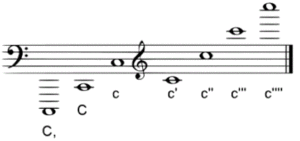There are eight different categories for the soprano voice in the Fach system separated into two main divisions, the Spiel- and Charakterfächer and the Seriöserfächer. Follow the links to both sound examples and an extensive listing of typical roles and audition arias.
Part one: Spiel- and Charakterfächer: [ʃpi:l ʊnt ka.’ʁak.tɐ ‘fɛ:.çɐ]
Spielsopran (Deutsche Soubrette) [‘ʃpi:l.so.’pʁa:n ‘dɔ:ʏ.ʧə zu.’brɛ.tə] (c’ to c”’)
- A light, supple voice; petite physical appearance; a versatile actress.
The Soubrette is the operatic equivalent of the Broadway ingénue. It is important that a singer of this category have an excellent command of language since many of the roles for this voice include extensive dialogue and/or recitative in both operetta and opera. Her voice must be flexible but it is not necessary to have the extreme high notes. The voice should be fairly full in the middle since she generally sings the middle voice in ensembles. The most typical role for the Deutsche Soubrette is Ännchen in Der Freischütz. She must look like a younger sister and have a lively personality, yet her voice must be strong enough to balance Agathe’s in the ensembles. Other typical roles for the Soubrette include Marzelline in Fidelio, Despina in Così fan tutte, and Musetta in La bohème. She might also sing many of the roles which are listed in the Lyrischer Koloratursopran Fach, provided her voice as the high notes and enough flexibility.
Example: Ileana Cotrubas in La Calisto.
Spielsopran (Soubrette) roles and arias
Lyrischer Koloratursopran (Kolortursoubrette) [‘ly:.ʁɪ.ʃɐ ko.lo.ʁa.’tu:ɐ̯.zo.’pʁa:n ko.lo.ʁa.’tu:ɐ.zu.’bʁɛ.tə] (c’-f'”)
- Very flexible, mellow voice with an extended top voice.
The main difference between the Koloratursopran and the Deutsche Soubrette is the ability to sing extremely high notes, fast coloratura passages, and to have a somewhat brighter sound. Her temperament, language facility, and acting ability are identical to that of the Deutsche Soubrette. Typical roles for this Fach are Zerbinetta in Ariadne auf Naxos, Blonde in Die Entführung aus dem Serail, Norina in Don Pasquale, and Olympia in Les contes d’Hoffmann.
Singers: Lilly Pons, Roberta Peters, Kathleen Battle
Example: Beverly Sills in Capuletti ed i Montecchi.
Lyrischer Koloratursopran roles and arias
Charaktersopran [ka.’ʁak.tɐ.so.’pʁa:n] (b-c”‘)
- Zwischenfach voice; able to achieve sensitive characterization.
The Charaktersopran is a specialty Fach that one very seldom encounters in all but the largest opera houses in Europe. The term Zwischenfach means the voice combines the lyric (singing) qualities of the Lyrischersopran and the dramatic ability of the Jugendlich-dramatischer voice. While she sings all the great Puccini soprano roles: Manon, Mimi, Tosca, Angelica and Butterfly, she may also take on some traditional mezzo roles such as Carmen and the Komponist in Ariadne auf Naxos. It is often the case that the Charaktersopran may have started her career as a mezzo and moved up to the soprano roles. Her German repertoire demands the dramatic intensity of a Salome or the Färberin in Die Frau ohne Schatten, her French repertoire includes such roles as Melisande and Mignon that require sensitivity and a fine sense of characterization. This is not a beginner’s Fach but is arrived at only after many years of professional singing.
Singers: Mezzos: Shirley Verrett, Grace Bumbry, and Maria Ewing. Sopranos: Regina Resnik, Helga Dernesch
______________________________________
Helmholz notation:

(This article is the third part in the series on the German Fach System and is based on information derived from Rudolf Kloiber’s “Handbuch der Oper”, 9th edition, Deutschen Taschenbuch Verlag. Read the first part of this series here.)
